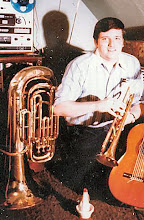
1962 Coral Records CRL 757419 Stereo / CRL 57419 Mono
Side One
1. Panama (Pete Fountain And Al Hirt)
2. St. Louis Blues Pete Fountain
3. All The Wrongs You've Done To Me (They're Bound To Come Back To You) (Pete Fountain And Al Hirt)
4. Lonesome Road (Pete Fountain)
Side Two
1. I Used To Love You (But It's All Over Now) (Pete Fountain And Al Hirt)
2. I've Found A New Baby (Pete Fountain)
3. It's A Long, Long Way To Tipperary (Pete Fountain And Al Hirt)
4. Mighty Like The Blues (Pete Fountain)
Liner Notes:
THE NEW ORLEANS SCENE featuring PETE FOUNTAIN and AL HIRT
Al Hirt and Pete Fountain have more in common than their New Orleans origins. Both are acknowledged representatives of a school of music that grew up in the South, and especially in the Crescent City. Both, significantly, have achieved in the past couple of years a degree of popular success with the public at large that would never have seemed conceivable in the early years of Dixieland jazz. But this in turn is due to another characteristic they have always shared: both are outgoing, personable musicians who are capable of making their performances acceptable to a broad audience; neither finds it necessary to limit himself to any in-group of intellectuals, fellow-musicians or music critics. Both enjoy and encourage a warm audience reaction.
That a great deal of valid music can be accomplished in this manner is made abundantly clear by these sides. Four of the tracks are played by a typical seven-piece Dixieland band in which Al and Pete are both heard. The other members of the combo are familiar to students of present-day New Orleans jazz. Jack Delaney, who completes the front line, studied at Southeastern Louisiana College and played during the 1950s with Sharkey Bonano and Tony Almerico before joining Al Hirt. Three of the four rhythm section men - pianist Roy Zimmerman, guitarist Joe Capraro and bassist Phil Darois--were heard in the album Al Hirt in New Orleans, and the fourth, drummer Arthur (Monk) Hazel, also a Bonano alumnus, is a 59-year-old pioneer whose career goes back to the Emmett Hardy band of 1920.
The other four tracks present Pete Fountain in a more intimate setting, flanked by what is now his regular West Coast rhythm section - Stan Wrightsman, piano; Bobby Gibbons, guitar; Morty Corb, bass and Jack Sperling, drums. The unpretentious routines for the tunes on this date were sketched by Bud Dant.
All eight of the vehicles used by these combos go back many years. Panama, played by the Hirt group, has a history that extends more than three decades and has been recorded by innumerable trumpeter-led groups, from Armstrong and Nichols to Davison and Daily. St. Louis Blues, the 1914 W. C. Handy blues bellwether, undergoes a smoothly-swinging revitalization in the hands of Pete and his rhythm section, with unmistakably modern touches in the solo spots by Sperling and Corb.
All The Wrongs You're Done To Me exhibits several facets of Al Hirt's musical personality that earned him respect among his contemporaries. The strong, assertive sound, the unhurried phrasing, the sometimes Armstrong-like melodic simplicity all are powerfully in evidence. The side ends with Pete's quintet in a revival of the 1928 Lonesome Road. Note the cohesion with which the rhythm section punctuates behind Pete's low-register statement of the theme.
A rousing example of the effective conversion of a popular song into traditional jazz terms is I Used To Love You But It's All Over Now, noteworthy here for excellent contributions by Hirt and Delaney. The song, incidentally, is even older than is generally realized: Albert Von Tilzer wrote the melody in 1920. Fountain's I've Found a New Baby, with a brisk series of four-bar trades by the leader and Sperling, is a Spencer Williams standard long associated with the 1928 version by Muggsy Spanier and the Chicago Rhythm Kings.
Tipperary was one of the big songs of World War I, internationally popular from 1917 on. As so often happens with old pop tunes, the chord pattern turned out to he ideal for jazz improvisation; Al's work here is equally brilliant in solo and ensemble. Mighty Like The Blues, though the youngest song on the set, goes back a long way. I wrote it in London in 1936, and the Duke Ellington version two years later was the first recording of any song of mine in this country. Barney Bigard's chalumeau clarinet was a feature then, and Pete's lower register is similarly showcased here, all the way down to the bottom D concert in the fourth bar of the theme. Gibbons' guitar provides an interesting link in the introduction and interludes; Pete, when not stating the melody, plays some highly attractive ad lib blues.
That Al Hirt and Pete Fountain made a potent team in the late 1950s is as evident as the success both have enjoyed since they branched out separately. The alternation between band performances and the tracks by Pete's present group offer an intriguing study in contrasts, as well as a reassuring reminder of the durability of this free-wheeling, unpretentious music - the kind of jazz with which both musicians, not too long ago, established an international reputation.
- LEONARD FEATHER



No comments:
Post a Comment